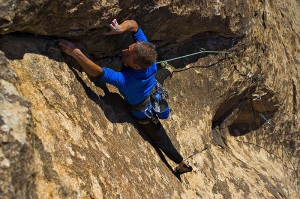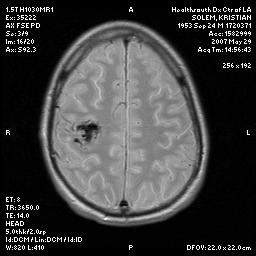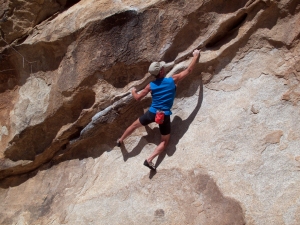“It’s your reaction to adversity, not the adversity itself, that determine’s how your life story will develop.” ~Dieter F. Uchtdorf
The story below comes from Kristian Solem and blows my mind. The guy is amazing. He’s lived an extraordinary life as a climber. He gets to see the world from a vantage point most won’t… from the face of rock walls in areas most will never venture to see. I hope his story will help you realize how precious each moment is, how important our physical health is, but also our mental approach to life.
It was May 27, 2007. I enjoyed the steep hike up to Church Dome, a paradise for rock climbers hidden away in California’s Domelands Wilderness. At 54 I was past my prime as an athlete, but I was in good shape and regularly out-performed climbers half my age. I was sitting on the edge of a small precipice taking in the view and watching my friends, three small figures winding their way up the slope. At times like this I would often think of the opening lines of Edward Abbey’s Desert Solitaire: “This is the most beautiful place on earth. There are many such places…”

Then my left hand began to tremor. Annoyed, I focused my attention to make it stop. Resistance was futile; the tremors intensified. Not knowing what was happening I crawled away from the precipice and rolled around in the dirt while convulsions took over my left arm, chest and finally my left leg. I felt my face being pulled in every direction, and my field of vision began to shrink. I will never forget that moment, I was certain that death was at hand. Please. It’s too soon; this isn’t supposed to happen yet… I fought with every fiber of my being, but lost the battle and surrendered.
I was coming to as my friends arrived. They saw me lying in the dirt and thought I had fallen from the cliff above while climbing free solo. After a minute I sat up and assured them this was not the case. I played down what had happened so no one really took it seriously, myself included, now that I was back among the living. Besides, we were 30 miles of rough dirt road from the nearest paved mountain road, and even further from cell reception. If I was about to drop dead there wasn’t much we could do about it. I climbed hard for the next few days.
Two weeks later, back at Church Dome, it happened again. I had told my wife about the first time, but since I downplayed it she didn’t worry. But this time she was there, and the seizure was more intense. Later, Barbara told me she could hear my eyelids clapping. I saw my regular physician, Dr. Lang, the next day. He interviewed me and began to do a series of strength and reflex tests. Suddenly his demeanor changed. “I’ve got a guy here who needs an MRI of the brain stat! Get him to the front of the line; tell them he’s on his way down now!” His assistant sprang into action. I was in a daze as I rode the elevator down to the imaging facility.
Later, as I walked in my front door, the phone rang. “Hello Kristian? This is Dr. Lang. We have a diagnosis. You have an AVM, an arteriovenous malformation.” He told me he had called Dr. Fred Edelman, a respected neurosurgeon and clinical professor at UCLA, who would see me the next day. He referred to Dr. Edelman as “an elder statesman in the field.”
The radiologist had sent the MRI films and report to Dr. Lang and had also given me a cd. I opened the disc on my computer and began glancing through the images assuming that only a specialist would see the problem. Then I hit an image which showed an obvious anomaly, what appeared to be a hole in the right side of my brain. Stunned by what I saw, I searched the web for AVM. I learned that it’s a birth defect where an artery turns directly into a vein without forming the bed of capillaries which nourish the cells and carry away the waste products of metabolism. These vascular defects grow over time and often bleed. Although they are very rare, AVMs are the leading cause of brain hemorrhages in young adults.

The next day Barbara and I sat in the darkened office of Dr. Edelman. My MRI films hung on light panels on the wall. “The location of your AVM is exquisite.” Barbara (an attorney) jumped in. “Exquisite?? What does exquisite mean in this context?” “The location of this AVM is exquisite, meaning that it cannot be treated surgically.” He went on to say that my AVM was located in the “motor control strips” in the right side of my brain. We moved into an examination room. Dr. Edelman asked me to strip down to my shorts. He led me through a set of physical tests; reflexes, strength, etc. “For someone with your problem you present very well. What do you do to stay in shape?” “I’m a climber.”
Dr. Edelman called Dr. Neil Martin, Chief of Neurosurgery at UCLA Medical Center. Two days later Barbara and I sat in his office. He concurred with Dr. Edelman. “No responsible surgeon would attempt to remove your AVM. The result would be catastrophic.” He told us there were several possible non-invasive treatment options and we should begin the process of exploring these. For the next two months I underwent brain angiograms, CT and MRI scans, functional brain mapping and more. One treatment after another was ruled out. A final option was left. I was to meet with a Dr. DeSalles who would decide if I was a candidate for a precise use of gamma radiation called stereotactic radiosurgery.
As I sat in the waiting room a gentleman in a white lab coat walked in. “Hi, are you Kristian? I’m Dr. Yoshida.” We sat in his office and chatted for about an hour. He asked about my home life, family, friends, work, my interests and hobbies. I mentioned climbing. “I’ve always wanted to know about this sport. For starters, how do you get the ropes up?” I drew a few diagrams of how the system works. “Have you climbed El Capitan in Yosemite?” “Yes.” “Very good. Let’s go meet Dr. DeSalles.”
Dr. DeSalles and several residents were studying my scans. He turned to Dr. Yoshida. “So, tell us about Kristian.” I was amazed as Dr. Yoshida distilled his knowledge of me from our hour together down to the essentials. He spoke for three minutes. It was all there. Dr. DeSalles looked me over. “I think I have some good news for you.” He went on to explain the process of stereotactic radiosurgery. Properly dosed, the radiation would destroy the DNA in the AVM’s cells but not the tissue itself. The cells would stop reproducing and the affected area would become scar tissue over two to three years. He asked me if I wanted to be a part of this program and undergo the procedure. I agreed without hesitation. The next two weeks were a blur of 3d imaging scans and consults with the doctors on the team. Finally medical physicists programmed my exact sequence into the machine, and treatment took place on August 16, 2007.
A year and a half later I was back on my game. I took medication to control seizures, but the effects were manageable. I was thrilled to be climbing again.
Photo credit, Randy Wenzel.


These pictures were taken post treatment. On top I am leading a climb in Joshua Tree National Park called “Black President.” It’s not cutting edge, but a route good climbers respect. On the bottom I’m just bouldering around. You can see the atrophy in my left arm, a result of muscle recruitment problems related to the AVM.
Since then there’ve been ups and downs, some bumps in the road. I’ve had allergic reactions to meds that worked well for me, and been forced to take ones that were intolerable. The list includes Dilantin, Keppra, Trileptol + Dexamethazone, back to Keppra, then Vimpat and now Lamictal. Since 2007 I’ve had a total of five seizures, not a big number, but each much more severe than the one before. I simply cannot have another, so I’ve faced the reality that the meds are for life. After two years working with neurologist Dr. Mark Nuwer at UCLA I have found one which seems to meet my needs.
So what is there to be grateful for? As a young man my AVM did not bleed. Many do. I could have been disabled or dead.
My AVM did not symptomize until there was a viable way to treat it. It held out until medical technology caught up.
My AVM did not interfere in any way with my love for physical activities until I reached 54. I used to be cocky, “You’re only as good as what you can climb right now, on demand.” Today it’s “no one can take away from you what you’ve done.”
And of course I am forever in debt to the doctors, technicians and staff at UCLA Medical Center. I am not wealthy, a pro athlete or a celebrity, but the availability of PPO insurance plans enable patients to move up through the various doctors quickly, without waiting for referrals from a primary physician. Also, I present well, and I’m proactive and take my interactions with doctors seriously. I walk into every appointment with a list of questions and write down the answers. Often I’ll review the answers with the doctor. Doctors see lots of patients. If you stand out in the crowd they will usually return your interest with their own.
I joke with my friends that I’m in pretty good shape from the neck down. Dr. DeSalles seemed to agree, saying once “You look a lot better on the outside than you do on the inside.” At first I was taken aback, but he smiled and we laughed. It was all good.
Another amazing story. Thank you for sharing.
LikeLike
I really love at the end how you listed out all that you are grateful for. I always think that a grateful heart is a healed heart 🙂 (or brain, for that matter 🙂 )
LikeLike
Thanks. Considering the situation I am very fortunate. I’ve surely had my “why me” times. Better to be, as you say, grateful for the good.
LikeLike
“No one can take away from you what you’ve done”. Spot on, Kristian.
LikeLike